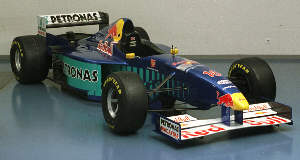
![]()
BTCC
British Motorsport
Features
TVR Tuscans
Alfa Romeos
VW Ventos
What's Coming
Our Sponsors
FORMULA ONE
SAUBER LAUNCHES DIGITAL CAR

The new Sauber C16 was today launched in a rather eerie fashion with not a single member of the press present. Instead, down the telephone lines of a thousand journalists all over the world the disembodied words of Team manager Peter Sauber, designer Leo Ress, Team Director Max Welti, Head of engine development Osamu Goto and the two drivers, Englishman Johnny Herbert and Italian Nicola Larini, appeared on glowing TV monitors in 20 different countries. This is not the first time that the Internet has been used to launch a car, Ferrari launched on line last year complete with live pictures of the car. At this event today however, there was no car, just a rather dull looking group of people sitting at a modernish desk, cans of Red Bull to the fore. The ever-so-slowly changing pictures didn’t really add to the rather frustrating atmosphere of the event and the questions via the standard Internet protocol of IRC were not exactly thick and fast and mostly seemed to be in German.
With the help of a downloadable press release and what questions one could decipher, one got the general gist of the occasion and some information however scant, about the car itself:
When asked to describe the latest creation of his design team in comparison to the previous model, Chief Designer Leo Ress gave a simple answer: "Even smaller and slimmer, even a little bit more compact."
Indeed the Red Bull-Sauber-Petronas C16, is significantly narrower in the front area. Following the latest trend the front nose box with the integrated crash structure has been made even higher and narrower. Some visible changes have been made in the cockpit area which is also narrower around the side crash structure. And the lower cockpit side design is a result of the aerodynamic findings of last season. It aims to improve the air flow in the airbox area from where the engine receives the air it needs.
The rear of the car has not been spared from the general slimming diet. It is also narrower. Further significant changes are the so-called rear wings improving downforce which have been placed between the side pods and rear tyres, a place designated by the new FIA Technical Regulations.
All these modifications are the result of weeks of meticulous aerodynamic work on a 50% scale model of the C16 in the wind tunnel at the Swiss National Airplane Works in Emmen/Switzerland, having a rolling road in order to simulate the air flow between the road surface and the car‘s undertray.
All this can be considered normal in the development of a new race car. But the engine decision (the supply of ’96 version Ferrari V10 engines) which was taken as late as November 1996 dictated a construction and fabrication schedule for the cars which can be compared to an emergency operation. "From the designer‘s point of view simply a nightmare," Leo Ress confesses. "From the driver‘s seatback, up to the rear light, our work was sometimes a gamble." However, for Team Red Bull-Sauber-Petronas the two-year contract with the traditional Italian race outfit secures the access to highly modern engine technology based on Ferrari‘s experience.
It wasn‘t until December that all designers and engine specialists could hold their first meeting. With the information received there they start working through their long list of tasks. Everything in the Red Bull-Sauber-Petronas C16 situated behind the driver had to be defined and constructed in the shortest possible time.
"On January 20, 1997 we completed the last drawings for the larger parts. When the last small details were designed and finalized, it was already the end of January," remembers Leo Ress clearly, in this extraordinary race against time.
What remains are the designers‘ worries that everything will function reliably and without any major problems at the first races of the season. But for the design team one thing is for sure: For the first time since their Formula One debut in the 1993 season Team Red Bull-Sauber-Petronas will not have to build a car around a completely new engine for next year.
Due to the nature of the medium, the questions fielded were inevitably fairly simplistic, however a few quotes were worthy of mention. When Osamu Goto was asked about engine supply he said "Taking into consideration that you will need 2 new engines for each race, it will be a total of between 30 and 40 engines." He added, "We will propose some changes to the engine because we have some ideas. Everything will be done together with Ferrari."
This reporter asked Leo Ross whether he had considered Bridgestone tyres as part of what must be now, a rather hurried test programme due to the tardiness of the cars launch. He said "Indeed due to the time left our test schedule is a very tight one. We will have to work very hard to catch up on testing mileage. The plan is to shake down the car from tomorrow in Fiorano and hopefully to do a second test next week in Barcelona, however our contract with Goodyear includes the 1997 season and we will fulfill this contract. Obviously we are following the situation on the tyre sector closely."
The drivers seemed a bit extraneous not being able to talk about their cars. I asked Johnny Herbert about his aspirations for the season. He was sensibly conservative in saying, "For the first year with the new engine it is more important to get a good understanding for Mr. Ress and Mr. Goto to further develop the car. It is very difficult to finish in the top five, but that is what we all are aiming for. I think we have a very good opportunity to join the big teams. Our package should be strong and as the season progresses we can consistently get more points."
A final word or two was said by Team manager Peter Sauber before the plug was pulled on the session. "For us this (Ferrari) agreement signifies the most important step ever since we decided to enter Formula One." He said, "Not only have we got an absolutely competitive engine for the 1997 season that bears comparison, but we now also acquire engine competence thus finally allowing us to plan strategically in this area."
Sauber do indeed seem to have a great package and even before the car turns a wheel it’s digital ‘launch’ gave the green light for unbridled optimism for the coming season.
Chris Richardson


